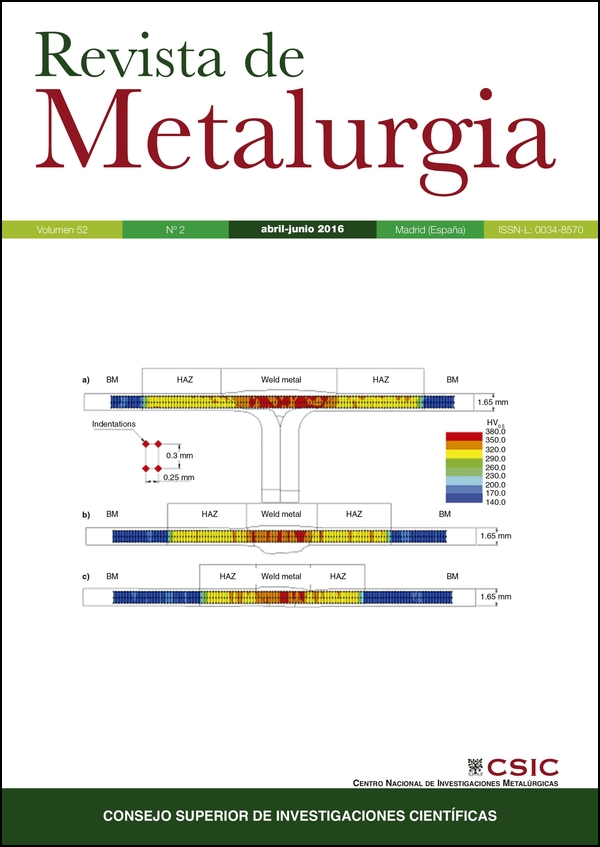Characterization of the surface oxidation reaction and its influence on the radiation absorption during the surface laser hardening process of the 42CrMo4 steel
DOI:
https://doi.org/10.3989/revmetalm.067Keywords:
Absorption, Hardening, Laser, Oxidation, Steel, SuperficialAbstract
Surface laser hardening of steel is a process that produces an enormous interest due to its uncountable advantages in terms of quality and productivity against induction hardening The effective implantation of this process, nevertheless, is been hampered because of the lack of reliable and flexible predictive tools. There are different models focused on the temperature calculation, thought, few make a thorough analysis of the surface oxidation associated with the process and its important implications over the absorption coefficient. This work proposes and explains a coupled model temperature/ oxidation available in literature, applied, for the first time, for the simulation of simple processes carried out with different conditions of power and speed, for the 42CrMo4 steel. These conditions have been reproduced experimentally, tracking the maximum surface temperature and the oxide thickness. Both results have shown a high degree of coincidence whit theoretical predictions, confirming the capabilities and utility of the model.
Downloads
References
Alvin, P., Penner, A.P., Rakhal C.B., Wendell, F. (2007). Activation energy and non-equilibrium effects in thermal reactions. Int. J. Chem. Kinet. 9 (3), 371-377.
Abuluwefa, H.T. (2012). Kinetics of high temperature oxidation of High Carbon Steels in Multi-component gases approximating industrial steel reheat furnace atmospheres. Proceedings of the International MultiConference of Engineers and Computer Scientist (IMECS 2012), Hong Kong, pp. 1664-1668.
Antonov, V., Iordanova, I., Gurkovsky, S. (2002). Investigation of surface oxidation of low carbon sheet steel during its treatment with Nd:Glass pulsed laser. Surf. Coat. Tech. 160 (1), 44-53. http://dx.doi.org/10.1016/S0257-8972(02)00344-4
Avery, H.E. (2002). Cinética química básica y mecanismos de reacción, Cap. IV: Dependencia de la velocidad con la temperatura, Editorial Revert., Barcelona, Espa.a, pp. 51-61.
Bailey, N.S., Tan, W., Shin, Y.C. (2009). Predictive modeling and experimental results for residual stresses in laser hardening of AISI 4140 steel by a high power diode laser. Surf. Coat. Tech. 203 (14), 2003-2012. http://dx.doi.org/10.1016/j.surfcoat.2009.01.039
Cordovilla-Bar., F., García-Beltrán, A., Ocaña-Moreno, J.L. (2014). Aplicación de modelos simplificados para la determinación de ventanas de trabajo para el temple de aceros por l.ser. Dyna 89 (5), 533-541. http://dx.doi.org/10.6036/7079
Cordovilla, F., García-Beltrán, A., Domínguez, J., Sancho, P., Ocaña, J.L. (2015). Numerical-experimental analysis of the effect of surface oxidation on the laser transformation hardening of Cr-Mo steels. Appl. Surf. Sci. 357, 1236-1243. http://dx.doi.org/10.1016/j.apsusc.2015.09.143
Duley, W.W., Semple, D.J., Morency, J.P., Gravel, M. (1979). Coupling coefficient for cw CO2 laser radiation on stainless steel. Opt. Laser Technol. 11 (6), 313-316. http://dx.doi.org/10.1016/0030-3992(79)90008-2
García-Beltrán, A., Marín, L.F., Ocaña, J.L. (2007). An.lisis de la influencia del factor de solapamiento en el tratamiento t.rmico de superficies extensas de aceros por l.ser. Rev. Metal. 43 (4), 284-293. http://dx.doi.org/10.3989/revmetalm. 2007. v43.i4.74. http://dx.doi.org/10.3989/revmetalm
García-Beltrán, A., Ocaña, J.L., Molpeceres, C.L. (2008). TEMPLUM: A process adapted numerical simulation code for the 3D predictive assessment of laser surface heat treatments in planar geometry. WSEAS Transactions on Computers 7 (2), 65-74.
Ion, J.C. (2005). Laser processing of engineering materials. Principles, procedure and industrial application. Chapter 9: Surface Hardening, Elsevier, Oxford, pp. 221-249.
Kechemair, D., Luneville, E. (1987). Modelisation de la tempre superficielle des aciers par laser CO2 continu. Rapport, .tablissement Technique Central de L'Armement (E.T.C.A.), France.
Leung, M.K.H., Man, H.C., Yu, J.K. (2007). Theoretical and experimental studies on laser transformation hardening of steel by customized beam. Int. J. Heat Mass Tran. 50 (23-24), 4600-4606. http://dx.doi.org/10.1016/j.ijheatmasstransfer.2007.03.022
Miettinen, J. (1997). Calculation of solidification-related thermophysical properties for steels. Metall. Mater. Trans. B 28 (2), 281-297. http://dx.doi.org/10.1007/s11663-997-0095-2
Miokovik, T., Schwarzer, J., Schulze, V., V.hringer, O., L.he, D. (2004). Description of short time phase transformations during the heating of steels based on high-rate experimental data. J. Phys. IV France 120, 591-598.
Nánai, L., Vajtai, R., George, T.F. (1997). Laser-induced oxidation of metals: state of the art. Thin Solid Films 298 (1-2), 160-164. http://dx.doi.org/10.1016/S0040-6090(96)09390-X
Oliveira, F.L.G., Andrade, M.S., Cota, A.B. (2007). Kinetics of austenite formation during continuous heating in low carbon steel. Mater. Charact. 58 (3), 256-261. http://dx.doi.org/10.1016/j.matchar.2006.04.027
Otero-Huerta, E. (2012). Corrosión y degradación de materiales, Cap.: Cinética de corrosión a alta temperatura (2. Ed.), Editorial Síntesis, Madrid, pp. 283-299.
Pantsar, H., Kujanp.., V. (2004). Diode laser beam absorption in laser transformation hardening of low alloy steel. J. Laser Appl. 16, 147-153. http://dx.doi.org/10.2351/1.1710879
Pantsar, H., Kujanp.., V. (2006). Effect of oxide layer growth on diode laser beam transformation hardening of steels. Surf. Coat. Tech. 200 (8), 2627-2633. http://dx.doi.org/10.1016/j.surfcoat.2004.09.001
Pryor, A., Réquiz, R., Berrocal, A., Miranda, A. (1986). Comportamiento a la oxidación a altas temperaturas de un acero AISI 316 modificado. Revista Latinoamericana de Metalurgia y Materiales 6 (1-2), 55-61.
UNE-EN-10083-1 (2008). Aceros para temple y revenido. Parte 1: Condiciones técnicas de suministro, AENOR, Madrid, España.
Published
How to Cite
Issue
Section
License
Copyright (c) 2016 Consejo Superior de Investigaciones Científicas (CSIC)

This work is licensed under a Creative Commons Attribution 4.0 International License.
© CSIC. Manuscripts published in both the printed and online versions of this Journal are the property of Consejo Superior de Investigaciones Científicas, and quoting this source is a requirement for any partial or full reproduction.
All contents of this electronic edition, except where otherwise noted, are distributed under a “Creative Commons Attribution 4.0 International” (CC BY 4.0) License. You may read the basic information and the legal text of the license. The indication of the CC BY 4.0 License must be expressly stated in this way when necessary.
Self-archiving in repositories, personal webpages or similar, of any version other than the published by the Editor, is not allowed.
















